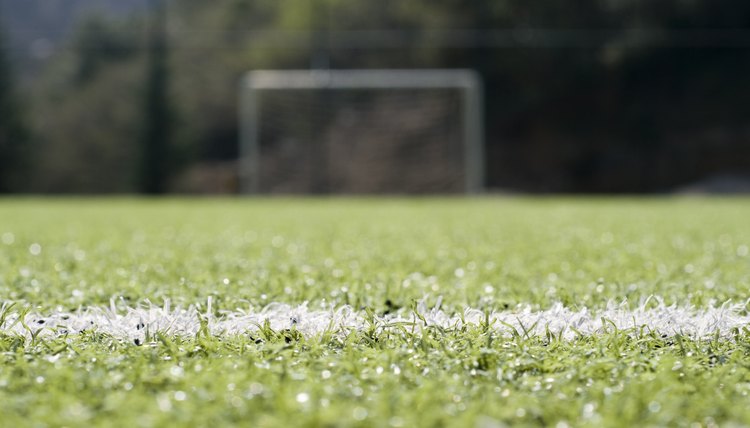What Is the Meaning of the Markings on a Soccer Field?

All levels of organized soccer use the same types of markings, on field sizes of varying sizes. Markings on the field tell the players and referees when the ball is in bounds or out, and where the goalie can use her hands. Once you know what all those straight and curved lines mean, you can map the field visually and use the rules to your advantage.
The Biggest Box
The long edges of the rectangular field edges are called the touchlines. If the ball passes over the touchlines, a player throws in the ball to put it back in play. The short edges of the rectangle are called the goal lines. If the ball passes over a goal line and the last touch was by a defensive player, an offensive player performs a corner kick from the area within a corner arc to inbound the ball. If the last touch was by an offensive player, the goalkeeper performs a goal kick to inbound the ball.
Around the Goal
The penalty box, a large rectangle, lies in front of each goal. Its forward edge is 18 yards away from the goal line. Within each penalty box is a smaller rectangular box that extends 6 yards out from the goal line. This is the goal area, and a goalkeeper must place the ball somewhere within it to perform a goal kick.
The Penalty Mark and Arc
If a team on the defense performs a foul within its own penalty box, the referee awards a penalty kick. Penalty kick marks are 12 yards from the goal line and in the middle of the field. In the event of a penalty kick, a player will shoot from here. Other players must wait outside the penalty arc, a small arc at the forward edge of the penalty box. The penalty arc helps referees ensure no players other than the kicker are closer than 10 yards to the ball.
The Center Circle
At the start of a game, one of the teams kicks off. Both teams must stay on their respective sides of the midfield line. The center circle, which has a radius of 10 yards, delineates the area that the team without the ball must not enter until a player first touches the ball.
References
- Soccer Rules Explained; Stanley F. Lover
- Coaching Soccer for Dummies; Greg Bach
Writer Bio
Stan Mack is a business writer specializing in finance, business ethics and human resources. His work has appeared in the online editions of the "Houston Chronicle" and "USA Today," among other outlets. Mack studied philosophy and economics at the University of Memphis.
